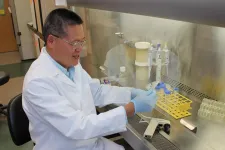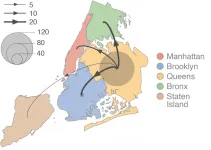(Press-News.org) Around the world and within the U.S., the percentage of people wearing masks during the Covid-19 pandemic has varied enormously. What explains this? A new study co-authored by an MIT faculty member finds that a public sense of "collectivism" clearly predicts mask usage, adding a cultural and psychological perspective to the issue.
The study uses a series of datasets about mask usage and public attitudes, along with well-established empirical indices of collectivism, to evaluate the impact of those cultural differences on this element of the pandemic response.
"Our data both within the United States and across the world shows that collectivism is a strong and important predictor of whether people in a region wear masks or not," says Jackson G. Lu, an assistant professor at the MIT Sloan School of Management and co-author of a new paper detailing the results.
Collectivism broadly refers to the inclination to prioritize a group's needs over an individual's concerns, and social scientists have often worked to measure its presence among different populations. The researchers found a culture of collectivism to be a key driver of mask use even after accounting for many other factors, including political orientation, state policies, the severity of Covid-19 outbreaks, and more.
"In collectivistic cultures, people consider wearing masks not only a responsibility or duty, but also, a symbol of solidarity -- that we're standing together and fighting this pandemic together," Lu says.
The paper, "Collectivism Predicts Mask Use During COVID-19," appears today in Proceedings of the National Academy of Sciences. The authors are Lu, who is the Mitsui Career Development Professor at MIT Sloan; Peter Jin, a research associate at MIT Sloan; and Alexander S. English, a researcher in the Department of Psychology and Behaviorial Sciences at Zhejiang University in Hangzhou, China.
To conduct the study, the researchers analyzed four datasets. The first, collected in July 2020, was a one-question survey about mask usage in the U.S., collected by The New York Times and research firm Dynata, and including 248,941 Americans across all 3,141 U.S. counties. The second dataset was a survey of 16,737 Americans across all 50 U.S. states about mask usage, from April through September 2020, run by YouGov and the Institute for Global Health Innovation.
Analyzing both datasets, the researchers examined how strongly mask wearing correlated with the measures of collectivism in the 50 U.S. states. A U.S. state's collectivism can be graded based on survey responses by representative samples of the population.
"Collectivism versus individualism is one of the most established cultural dimensions in psychology," Lu says.
In analyzing the results, the researchers controlled for a large set of other factors that might influence mask wearing, including the severity of Covid-19 outbreaks in states, government policies, political affiliations across the public, education levels, population density, per-capita income, age, and gender.
They found that a U.S. state's collectivism rating is a strong and consistent predictor of mask usage no matter what. For example, Hawaii, has the highest collectivism rating in the U.S., and the second-highest level of mask usage (slightly behind Rhode Island). On the other end of the spectrum, a handful of states from the Great Plains and Mountain West have both low collectivism scores and low levels of mask wearing, including Wyoming, South Dakota, Montana, and Kansas.
"The patterns across the two U.S. datasets are so strikingly similar, which made us feel confident of the link between collectivism and mask use," Lu says.
The researchers also used two global datasets to apply the same method to a set of countries. The first dataset was based on the same 2020 survey conducted by YouGov and the Institute for Global Health Innovation, this time generating data on mask usage from 367,109 people from 29 countries and territories.
The second global dataset is one the MIT researchers developed in collaboration with Facebook, creating a weighted survey on mask use that generated responses from 277,219 participants in 67 countries and territories.
In countries around the world, as in the U.S., the results were the same: Collectivism scores again predict which countries tended to have high levels of mask wearing.
The research also uncovered other factors that influenced mask wearing. For instance, in the U.S., party affiliation was also a strong predictor of mask wearing, with Democrats more likely to wear masks than Republicans.
Lu suggests there are multiple kinds of future research that could stem from the current study. For one thing, the role of collectivism could be studied in other crises, such as wildfires or hurricanes. Beyond that, the authors suggest, it would be important to study whether or not the pandemic itself has affected the sense of collectivism or individualism that has previously been measured in countries and U.S. states. Both of those things could be useful knowledge for public officials and policymakers, whether to curb the current pandemic or save lives in the future.
"Understanding cultural differences not only provides insight into the pandemic, but helps the world prepare for future crises," Lu says.
INFORMATION:
Written by Peter Dizikes, MIT News Office
Paper: "Collectivism Predicts Mask Usage During the COVID-19 Pandemic"
https://www.pnas.org/content/118/23/e2021793118
Flies predict changes in their visual environment in order to execute evasive maneuvers, according to new research from the University of Chicago. This reliance on predictive information to guide behavior suggests that prediction may be a general feature of animal nervous systems in supporting quick behavioral changes. The study was published on May 20 in PLOS Computational Biology.
Animals use their sensory nervous systems to take in information about their environments and then carry out certain behaviors in response to what they detect. However, the nervous system takes time ...
The immune system is a complex balancing act; if it overreacts or underreacts to foreign molecules, there can be serious health consequences.
For cancer patients, tumor progression is often accompanied by immunosuppression, meaning their bodies can't fight off pathogens the way they should. By contrast, for people with autoimmune diseases like type 1 diabetes, rheumatoid arthritis, and multiple sclerosis, their immune systems overreact and attack the body itself.
Both of these reactions are influenced by a series of molecular checkpoints found in both immune cells and cancer cells. In immune ...
Oysters live and grow in saltwater. However, the saltiness of their habitat can change dramatically, especially where the mighty Mississippi River flows into the Gulf of Mexico. Louisiana oysters from the northern Gulf of Mexico may experience some of the lowest salinity in the world due to the influx of fresh water from the Mississippi River. In addition, increased rainfall and large-scale river diversions for coastal protection will bring more fresh water that does not bode well for the eastern oyster. New research led by Louisiana State University (LSU) alumna Joanna Griffiths from Portland, Oregon, and her faculty advisor ...
ROCHESTER, Minn. -- You might be older - or younger - than you think. A new study found that differences between a person's age in years and his or her biological age, as predicted by an artificial intelligence (AI)-enabled EKG, can provide measurable insights into health and longevity.
The AI model accurately predicted the age of most subjects, with a mean age gap of 0.88 years between EKG age and actual age. However, a number of subjects had a gap that was much larger, either seemingly much older or much younger by EKG age.
The likelihood to die during follow-up was much ...
During the pandemic, the old waiting room phrase "the doctor will see you now" has taken on a new meaning. So has the waiting room. Our kitchen table or living room couch is where many people do work lately, and that includes visits to the doctor. New research from Syracuse University's Falk College indicates this method of health care will continue even after COVID numbers are (hopefully) reduced.
"I was surprised by the results," said the study's lead author Bhavneet Walia, assistant professor of public health at Syracuse University. "I initially thought that, because of the challenges of telehealth, physicians would not be in favor of continuing post-pandemic. It turns out they do. But ...
Researchers have long been interested in finding ways to use simple hydrocarbons, chemicals made of a small number of carbon and hydrogen atoms, to create value-added chemicals, ones used in fuels, plastics, and other complex materials. Methane, a major component of natural gas, is one such chemical that scientists would like to find to ways to use more effectively, since there is currently no environmentally friendly and large-scale way to utilize this potent greenhouse gas.
A new paper in Science provides an updated understanding of how to add functional groups onto simple hydrocarbons like methane. Conducted by graduate students Qiaomu Yang and Yusen Qiao, postdoc Yu Heng Wang, and led by professors Patrick J. Walsh and Eric J. Schelter, this new and highly detailed mechanism ...
HOUSTON - (May 20, 2021) - It's always good when your hard work reflects well on you.
With the discovery of the giant polarization rotation of light, that is literally so.
The ultrathin, highly aligned carbon nanotube films first made by Rice University physicist Junichiro Kono and his students a few years ago turned out to have a surprising phenomenon waiting within: an ability to make highly capable terahertz polarization rotation possible.
This rotation doesn't mean the films are spinning. It does mean that polarized light from a laser or other source can now be manipulated in ways that were previously out of reach, making it completely visible or completely opaque with a device that's extremely ...
At the start of the COVID-19 outbreak, a University of Illinois Chicago researcher conducted a survey asking respondents if they experienced health care delays because of the pandemic. In addition to learning about the types of delays, the study also presented a unique opportunity to capture a historic moment at the pandemic's beginning.
Elizabeth Papautsky, UIC assistant professor of biomedical and health information sciences, is first author on "Characterizing Healthcare Delays and Interruptions in the U.S. During the COVID-19 Pandemic Using Data from an Internet-Based Cross-Sectional ...
During the first phase of the COVID-19 epidemic, New York City experienced high prevalence compared to other U.S. cities, yet little is known about the circulation of SARS-CoV-2 within and among its boroughs. A study published in PLOS Pathogens by Simon Dellicour at Université Libre de Bruxelles, Belgium, Ralf Duerr and Adriana Heguy at New York University, USA, and colleagues describe the dispersal dynamics of COVID-19 viral lineages at the state and city levels, illustrating the relatively important role of the borough of Queens as a SARS-CoV-2 transmission hub.
To better understand how the virus dispersed throughout New York ...
Ancient pollen samples and a new statistical approach may shed light on the global rate of change of vegetation and eventually on how much climate change and humans have played a part in altering landscapes, according to an international team of researchers.
"We know that climate and people interact with natural ecosystems and change them," said Sarah Ivory, assistant professor of geosciences and associate in the Earth and Environmental Systems Institute, Penn State. "Typically, we go to some particular location and study this by teasing apart these influences. In particular, we know that the impact people have goes back much earlier than what is typically ...






